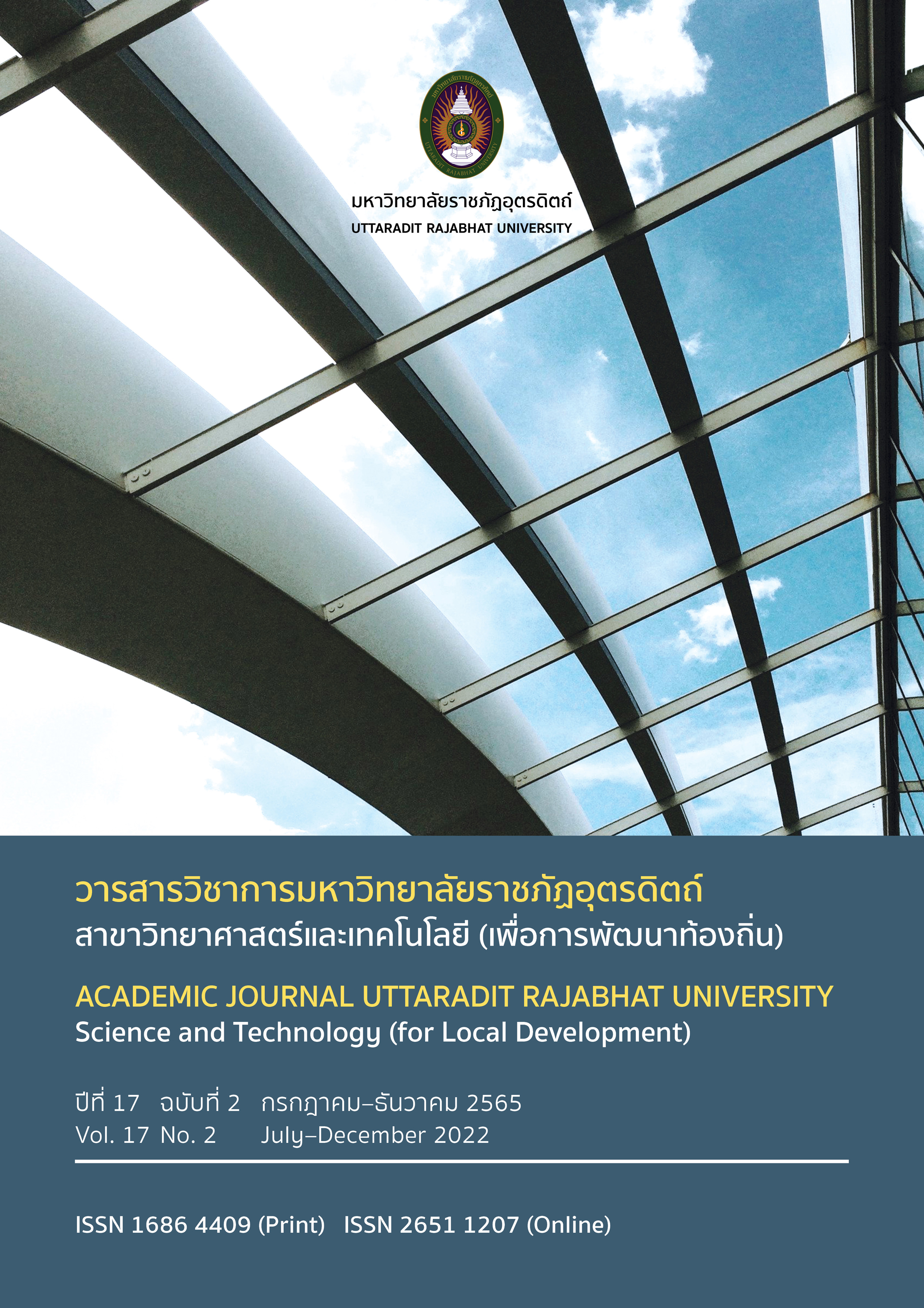UTILIZATION OF BLACK SOLDIER FLY LARVAE FOR LAYER CHICKEN DIETS OF FARMERS IN BAN NON SALA, SAKON NAKHON PROVINCE
Main Article Content
Abstract
The objective of this study was to determine the utilization of black soldier fly larvae for laying chicken diets. Thirty 34 to 46 week-old laying hens were randomly divided into 5 treatment groups. Each group consisted of six replicates of one bird. The dietary treatments were given to the groups of 1, 2, 3, 4 and 5 with the mixed ratios of the feed containing the black soldier fly larvae and the regular chicken feed at 0:100, 30:70, 60:40, 90:100 and 100:0, respectively. The results showed that treatment groups 1 and 2 had significantly increase in hen-day production and egg mass (p<0.01). The treatment groups 3 and 5 had highest feed intake per dozen eggs (p<0.05), whereas the treatment 5 had highest feed cost per dozen eggs (p<0.05).The treatment groups 1, 2, 3 and 4 had highest shell breaking strength (p<0.01), whereas the treatment groups 1 and 2 had highest shell thickness (p<0.05). The treatment groups 3, 4 and 5 had higher feed cost than that of the groups 1 and 2 (p<0.01), whereas the groups 1 and 2 had highest net income (p<0.01). It was concluded that the optimum mixed ratio of feed containing black soldier fly larvae and regular layer chicken diet was 30:70 as it resulted in an increase in net income. The findings of the study led to the promotion among the farmers in the village of Non Sala, Chiang Kruea Sub-district, Mueang District, Sakon Nakhon Province to feed layer hens with mixture of commercial chicken diets and black soldier fly larvae which could reduce the expense for purchasing only the commercial chicken feed.
Downloads
Article Details

This work is licensed under a Creative Commons Attribution-NonCommercial-NoDerivatives 4.0 International License.
References
กานดา ล้อแก้วมณี และกชพรรณ สีดารักษ์. (2561). ผลของระยะเวลาในการเก็บรักษาต่อคุณภาพไข่ไก่อินทรีย์ในสภาพอุณหภูมิตู้เย็น. วารสารเกษตรพระจอมเกล้า, 36(3), 125-135.
จักรพัทร มาลามณีรัตน, บัวเรียม มณีวรรณ์, กฤดา ชูเกียรติศิริ, และจุฬากร ปานะถึก. (2563). การใช้ผงหนอนแมลงวันลายที่เลี้ยงด้วยกากเต้าหู้ในอาหารไก่เนื้อต่อสมรรถภาพการเจริญเติบโต องค์ประกอบซาก และคุณภาพเนื้อ. แก่นเกษตร, 48(4), 942-953.
ธาริณี ยี่คิ้ว, ภาณีดา ภุมจุรีรัตน์, อภิญญา สุโยธีธนรัตน์, ประภัสสร ปลาดีพันธ์ดี, สุรัตน์ ลอมไธสง, กิตติกร สุริวงค์, ยิ่งลักษณ์ มูลสาร, และปรีชา มูลสาร. (2559). การศึกษาประสิทธิภาพของใบกล้วยหมักต่อสมรรถภาพการผลิตของไก่ไข่. วารสารสัตวแพทยศาสตร์ มข., 26(1), 1-14.
ประภากร ธาราฉาย. (2560, 1 กุมภาพันธ์). การเลี้ยงและการจัดการไก่ไข่. http://www.as2.mju.ac.th/E-Book/t_prapakorn/สศ451/บทที่%205%20การเลี้ยงและการจัดการไก่ไข่_3.pdf
ไพบูลย์ ใจเด็ด. (2565). บรรณาธิการแถลง. วารสารสัตวบาล, 32(133), 6.
ภาคภูมิ ซอหนองบัว, ธีรเจต สายธนู, และสุวิทย์ ทิพอุเทน. (2564). ผลของการใช้หนอนแมลงวันลายป่นทดแทนอาหารสำเร็จรูปต่อสมรรถภาพการผลิตและคุณภาพไข่ของนกกระทาญี่ปุ่น. แก่นเกษตร, 48(1), 538-542.
ภุชงค์ วีรดิษฐกิจ และไพโชค ปัญจะ. (2558). อิทธิพลของการเสริมใบมะรุมในอาหารไก่ไข่ต่อสมรรถภาพการผลิตและคุณภาพไข่. วารสารวิทยาศาสตร์และเทคโนโลยี, 23(2), 293-305.
วินัย เหลืองวิโรจน์. (2544). การวิเคราะห์ต้นทุนการผลิตไข่ไก่เพื่อการตัดสินใจ: กรณีศึกษา ฟาร์มสมควร จังหวัดพิษณุโลก [วิทยานิพนธ์ปริญญาโท, มหาวิทยาลัยเชียงใหม่]. http://search.lib.cmu.ac.th/search/?searchtype=.&searcharg=b1282297
ศมณพร สุทธิบาก, สมควร โพธารินทร์, รฐานิษฐ์ สุขธนาภิรัตน์, กีรติ มณีฉาย, ณัฐปภัสร์ จันทร์สาขาธนา, อาภรณ์ ศรีมาตร, และอำพร วงศ์ยะมะ. (2561). คู่มือการเลี้ยงหนอนแมลงวันลาย. อุดมทรัพย์การพิมพ์.
ศรุติวงศ์ บุญคง, ชัยพฤกษ์ หงษ์ลัดดาพร, สว่าง กุลวงศ์, สุธาสินี ครุฑธกะ, และพิทักษ์ น้อยเมล์. (2564). ผลการใช้กากปลาร้าในอาหารไก่ไข่ต่อสมรรถภาพการผลิต คุณภาพไข่และผลตอบแทนทางเศรษฐกิจ. แก่นเกษตร, 49(ฉบับพิเศษ), 452-457.
สุจินดา เจียมศรี. (2558). เศรษฐศาสตร์ธุรกิจ. สำนักพิมพ์มหาวิทยาลัยนเรศวร.
สุวรรณี กาญจนภูสิต. (2564, 8 เมษายน). ราคาสินค้าปศุสัตว์ที่เกษตรกรขายได้ สัปดาห์ที่ 1 เดือนเมษายน 2564. กรมปศุสัตว์. https://dld.go.th/th/index.php/th/newsflash/310-costprice-cat/23660-infoprice-256404-1.
อุทยานหลวงราชพฤกษ์. (2563, 6 กุมภาพันธ์). หนอนกำจัดขยะแมลงวันลาย. https://www.royalparkrajapruek.org/Knowledge/view/104
อุทัย คันโธ. (2559). อาหารสุกรและสัตว์ปีกเชิงประยุกต์. ยู เค ที พับลิชชิ่ง.
Bovera, F., Piccolo, G., Gasco, L., Marono, S., Loponte, R., Vassalotti, G., Mastellone, V., Lombardi, P., Attia, Y. A., & Nizza, A. (2015). Yellow mealworm larvae (Tenebrio molitor, L.) as a possible alternative to soybean meal in broiler diets. British poultry science, 56(5), 569–575.
Chu, X., Li, M., Wang, G., Wang, K., Shang, R., Wang, Z., & Li, L. (2020) Evaluation of the low inclusion of full-fatted Hermetia liiucens larvae meal for layer chickens: Growth performance, nutrient digestibility, and gut health. Frontiers in Veterinary Science, 7, 1-7.
Marco, M. De, Martínez, S., Hernandez, F., Madrid, J., Gai, F., Rotolo, L., Belforti, M., Bergero, D., Katz, H., Dabbou, S., Kovitvadhi, A., Zoccarato, I., Gasco, L., & Schiavone, A. (2015). Nutritional value of two insect larval meals (Tenebrio molitor and Hermetia illucens) for broiler chickens: Apparent nutrient digestibility, apparent ileal amino acid digestibility and apparent metabolizable energy. Animal Feed Science and Technology, 209, 211-218.
Newton, L., Sheppard, C., Watson, D. W., Burtle, G., & Dove, R. (2005). Using of Black soldier fly, Hermetia illucens, as a value added tool for the management of swine manure. North Carolina University, USA.
Park, Byung-Sung, Um, Kyung-Hwan, Choi, Won-Keun, & Park, Sang-O. (2017). Effect of feeding black solider fly pupa meal in the diet on egg production, egg quality, blood lipid profiles and fecal bacteria in laying hens. European Poultry Science, 81, 1-12.
SAS. (2004). STAT User’s Guide. North Carolina, USA.
Tomberlin, J. K., & Sheppard, D. C. (2001). Lekking behavior of the Black soldier fly (Diptera: Stratiomyidae). Florida Entomologist, 84(4), 729-730.


